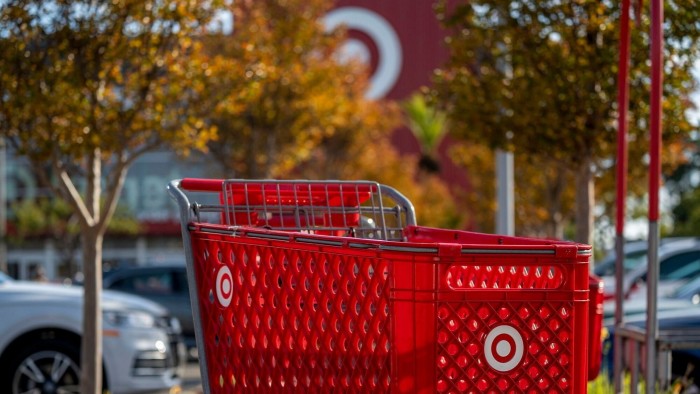Unlock the Editor’s Digest for free
Roula Khalaf, Editor of the FT, selects her favourite stories in this weekly newsletter.
Target shares plunged on Wednesday after one of America’s biggest retailers forecast disappointing sales for the key holiday season.
Executives pointed to weakness in sales of items beyond essentials such as groceries and cost pressures as the company lowered profit guidance for the current fiscal year, reversing a rise to the outlook made in August.
The chain expects profits of between $1.85 and $2.45 per share in the current quarter, well below the $2.66 expected by Wall Street analysts. Sales will be flat in the period, Target said.
Target shares were down 19 per cent in pre-market trading, dragging down those of rivals such as Dollar Tree and Dollar General.
The forecast came as Target’s third-quarter results were hit by the shortlived dockworkers’ strike, in the latest sign of how the labour stand-off affected the US economy.
Its third-quarter profit fell 12 per cent to $854mn. Analysts surveyed by Visible Alpha had expected earnings of more than $1bn.
The disappointment reflected in part Target’s efforts to secure goods before members of the International Longshoremen’s Association walked out on October 1, freezing container ports from Maine to Texas.
The union ended the strike in three days when it agreed to temporarily extend its contract with shipping lines until January 15.
Importers accelerated deliveries or rerouted them to west coast ports in preparation for the strike, adding warehousing and transport costs, according to the National Retail Federation.
Michael Fiddelke, Target’s chief operating officer, said his company had brought in some products sooner than usual to ensure they would be available for the holiday shopping season.
“When we take in product early, that means we hold it a bit longer, we usually touch it a bit more. That comes at a cost, both in our distribution centres and our store back rooms,” he said.
The costs of handling the inventory surge added to a lacklustre quarter for Target. Comparable sales rose 0.3 per cent, below estimates of a 1.4 per gain. Sales from stores open at least a year declined 1.9 per cent, even as comparable digital sales rose 10.8 per cent.
The results came a day after Walmart, Target’s biggest competitor, blew past estimates with US comparable sales growth of 5.3 per cent.
Walmart’s chief executive Doug McMillon said the financial impact of the port strike and two hurricanes that devastated parts of the US south had been relatively modest.
Target ended the third quarter on November 2 with $15.2bn in inventory, up 2.9 per cent from a year ago.
“I think we have the appropriate approach for the holiday season. Based on some of the trends we are seeing year to date, we are guiding with some conservatism, hoping there will be some upside as we get into the season,” said chief executive Brian Cornell.
Target has said it will cut prices for more than 2,000 items during the holiday shopping season, including food and essentials as well as gifts.
Similar discounts on thousands of items this year helped revive sales growth after a slump that lasted more than a year following negative reactions to Target’s Pride Month displays in 2023.
In its latest quarter, Target said the number of transactions had risen 2.4 per cent from a year before but customers paid 2 per cent less per transaction. Revenue rose 1.1 per cent to $25.7bn in the quarter, slightly less than estimates.
Read the full article here

